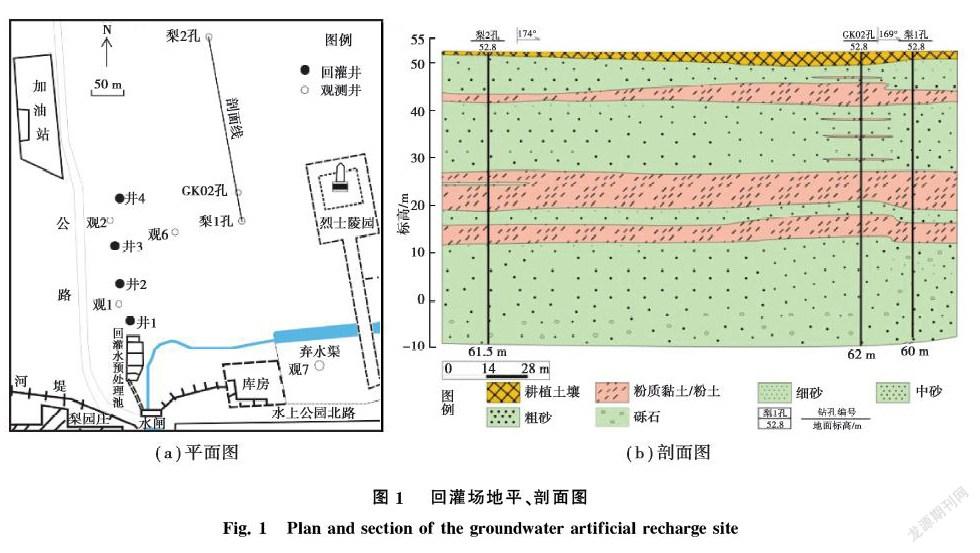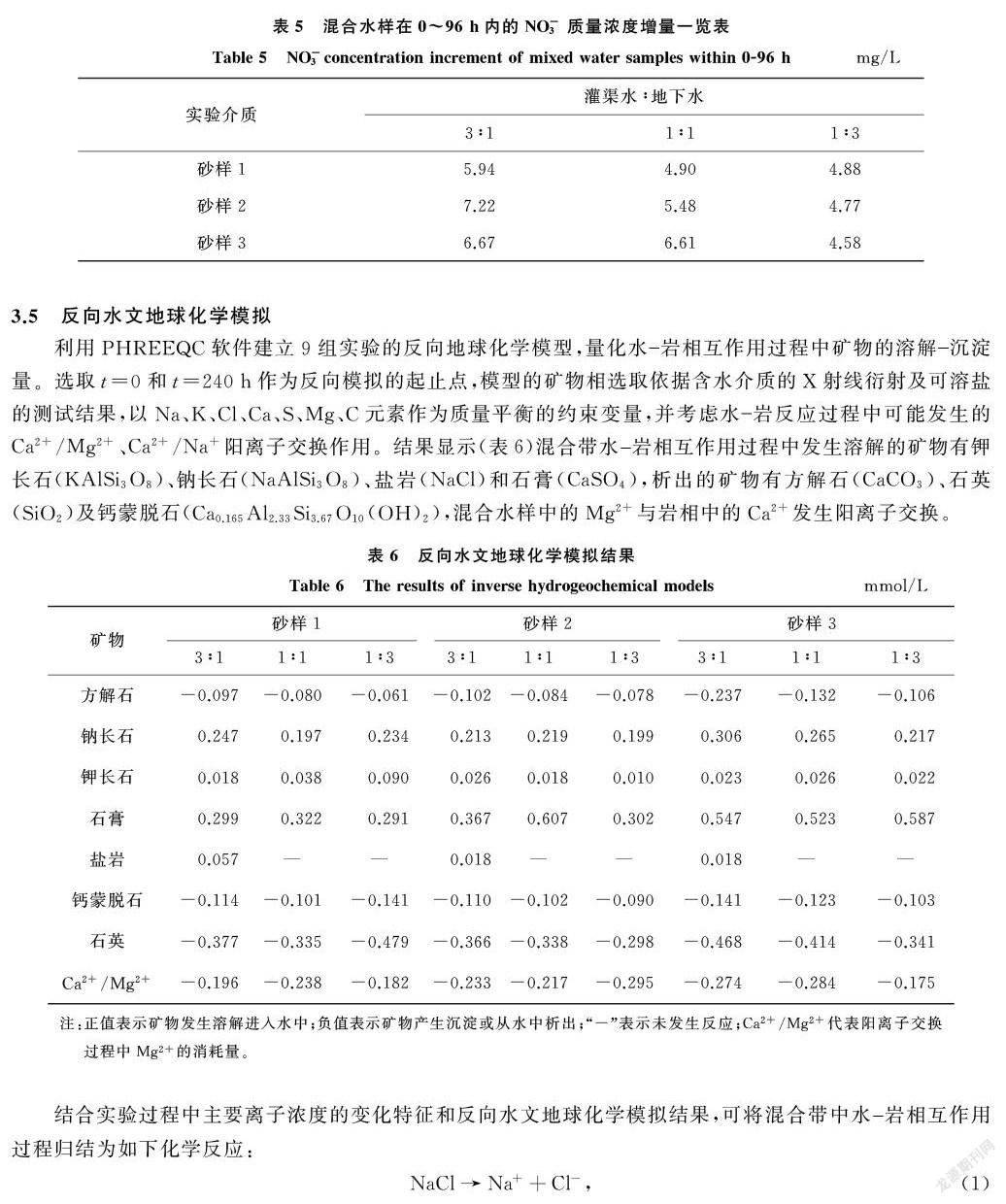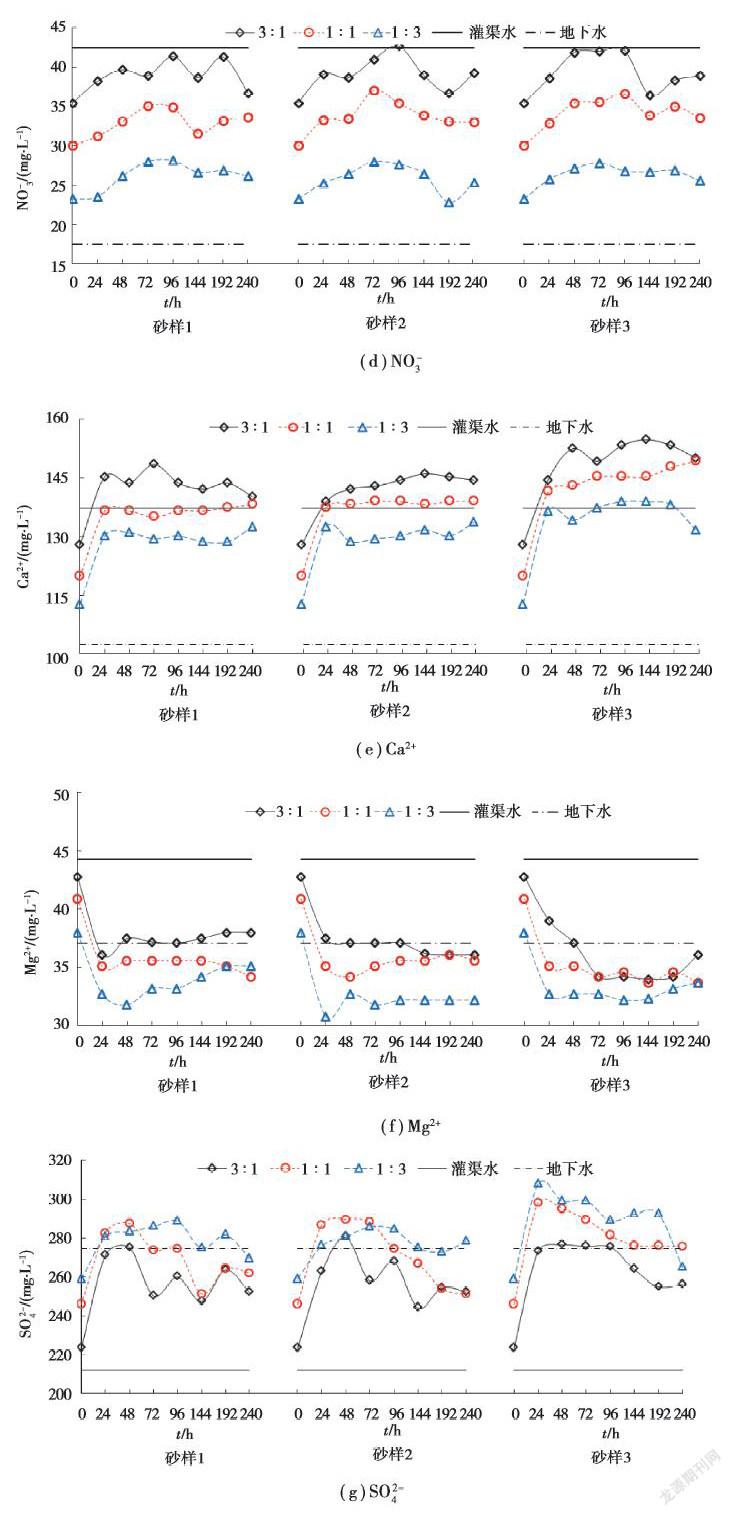滹沱河地下水超采区人工回灌的水岩相互作用模拟
2022-03-07耿新新张凤娥朱谱成马琳娜陈立郭春艳
耿新新 张凤娥 朱谱成 马琳娜 陈立 郭春艳











摘要:人工回灌條件下回灌水与地下水混合带的水岩相互作用是决定地下水水质演化和含水层发生化学堵塞的关键过程。为研究人工回灌对滹沱河地下水超采区水质演化的影响,以石家庄市人工回灌场地为例,利用石津灌渠水作为回灌水源,通过室内实验结合反向水文地球化学模拟揭示回灌层位地表水与地下水混合带的水
关键词:人工回灌;水岩反应;反向水文地球化学模拟;化学堵塞
中图分类号:P641.3
文献标志码:A文章编号:1000-582X(2022)02-081-13
Abstract: The water-rock interaction in the recharge water and groundwater mixed zone of aquifer under artificial recharge is the key process that determines the evolution of groundwater quality and leads to the chemical clogging of aquifer. To study the effect of artificial recharge on the groundwater quality evolution in the groundwater over-exploited area of the Hutuo River Basin, taking the groundwater artificia recharge site in Shijiazhuang as an example and using the Shijin irrigation canal water as the recharge water, we revealed the mechanism of water-rock interaction of surface water and groundwater mixed zone in the aquifer by carrying out the laboratory experiments and reverse hydrogeochemical simulation. The results show that the evolution characteristics of total dissolved solids(TDS) in the mixed zone firstly increase and then slowly decrease. The larger the proportion of surface water mixed with water is and the smaller the particle size of medium is, the larger the variation amplitude of TDS is. The change of main ion concentrations is controlled by mixing action, carbonic acid balance, dissolution-precipitation, cation exchange and nitrification. Among them, the concentrations of K+, Ca2+and SO2-4 are mainly controlled by dissolution-precipitation, the concentrations of Na+, Cl-, HCO-3, NO-3 are mainly controlled by mixing action, and the concentration of Mg2+ is mainly controlled by cation exchange. In the water-rock reaction, the dissolved minerals include anhydrite, albite, K-feldspar and halite, whereas the precipitated minerals included calcite, calcium montmorillonite and quartz. Moreover, in the aquifer with larger proportion of surface water and finer particle size of medium, the calcite precipitation is greater, indicating that there is a high risk of carbonate chemical clogging in the recharge aquifer with fine particle size when the surface water is the recharge source.
Keywords: artificial recharge; water-rock reaction; inverse hydrochemical simulation; chemical clogging
滹沱河浅层地下水超采区是华北平原地下水超采最强烈、地下水降落漏斗影响范围最大的地区[1],严重制约了当地经济社会的可持续发展。利用回灌井人工补给地下水是提高地下水位、遏制地下水漏斗发展的有效手段[2,3]。再生水[4,5]、雨洪水[6,7]及地表水[8,9]均可作为回灌水源,但回灌水与地下水的水质通常存在明显差异,因此,人工回灌过程是否会对地下水环境质量产生负面影响受到国内外学者的广泛关注。苏小四等[10]利用TOUGHREACT模拟预测了人工回灌条件下地下水中多组分溶质的迁移转化过程,结果显示地下水中化学成分变化趋势主要受回灌水水质及含水介质矿物成分的影响。郑凡东等[8]通过室内实验模拟了丹江口水库水回灌北京西郊地下水的水岩作用过程,发现回灌过程中发生了明显的硝化反应。李倩雯等[11]根据北京水源四厂的回灌试验数据,利用PHREEQC软件进行了水质混合模拟和水质预测研究。回灌水源与地下水混合带的水岩相互作用过程,不仅是影响地下水环境质量的关键,还会导致含水层发生化学堵塞,从而影响回灌工程的运行效率,Pavelic等[12]利用再生水回灌时,发现含水层的化学堵塞主要受回灌水源水质变化的影响。Vanderzalm等[13]研究城市雨洪水回灌碳酸盐岩含水层的水文地球化学过程,指出回灌水源本身的反应活性是影响矿物溶解沉淀过程的主要因素。Medina等[14]指出地下水中含氧量的变化易导致回灌井壁周边产生氢氧化铁水垢形成堵塞。由于建造回灌井的耗资较大,在开展回灌之前采用室内实验和数值模拟对回灌过程的水质演化进行预测,对维护和保障回灌工程安全高效地运行具有重要的指导意义。已往关于华北平原地下水回灌过程的研究多关注南水北调水对地下水水质的影响[8,15],利用当地地表水回灌地下水的水岩相互作用研究较少,其机理尚不清楚。笔者以滹沱河地下水超采区人工回灌场地为例,通过室内实验结合反向水文地球化学模拟,分析回灌层位地表水与地下水混合带的水岩相互作用机理,判别回灌过程是否存在化学堵塞风险,以期为安全高效地开展地下水人工回灌工程提供科学依据。
1 实验背景与实验方法
1.1 场地概况及含水层特征
回灌试验场地位于石家庄市藁城区梨园庄村东北角(图1),东西宽约400 m,南北长约500 m,由4个回灌井和8个观测井组成。回灌目标含水层为埋深39~60 m处的砂层,产状近水平,岩性由灰白色细砂、灰黄色中粗砂、灰黄色含砾粗砂及少量砾石组成,该含水层横向延伸性好,富水性强,单井涌水量1 000~3 000 m3/d,具有较强的回灌潜力[16]。
对回灌目标含水层的3段粒径差异较大的岩芯进行了粒径分析(表1),其中砂样1中粗砂占比最大;砂样2中中砂占比最大;砂样3中细砂占比最大。将砂样送至实验室以5∶1的水土比浸泡并振荡3 min后进行砂样盐分测定,全盐量采用蒸干法测定,HCO-3采用双指示剂中和法测定,Ca2+、Mg2+、Cl-、SO2-4采用滴定法测定,Na+、K+采用火焰光度计测定,pH采用点位法测定。各砂样的可溶盐测试结果显示(表2),目标含水介质的pH为8.18,其中砂样1中的易溶盐成分含量最少,砂样3中的易溶盐成分含量最多,并且3种砂样中都呈现出Ca2+、SO2-4、HCO-3含量较多,Na+、Cl-、K+、Mg2+含量较少。通过X射线衍射和电镜扫描分析确定含水介质的主要矿物为石英、钾长石、钠长石、方解石、白云石、盐岩、石膏、伊利石、高岭石和蒙脱石。
1.2 场地地下水与回灌水水质特征
回灌水源采用石津灌渠水,其来源为滹沱河上游的黄壁庄水库。灌渠水和回灌场地地下水的水质均良好,pH分别为7.55和8.18,均偏碱性,水化学类型分别为HCO3·SO4-Ca和SO4·HCO3-Ca型。对比灌渠水与地下水中的水化学测试結果(表3),灌渠水中的溶解氧(DO)、氧化还原电位(Eh)、Ca2+、Mg2+、HCO-3、NO-3和NH+4高于地下水,地下水的K+、Na+、Cl-和SO2-4质量浓度高于灌渠水。
3.6 讨 论
1)碳酸岩盐沉淀是地下水人工回灌过程中导致化学堵塞的主要因素之一[23],但回灌过程中水化学演化导致的化学堵塞的时间尺度跨度非常大,因此通常采用水文地球化学模型开展矿物沉淀风险的评估[24,25]。对比表5中反向水文地球化学模拟结果可知,在相同介质不同混合比条件下水中的方解石沉淀量大小依次均为3∶1>1∶1>1∶3,相同混合比水样与不同粒径的介质作用后方解石沉淀量大小依次均为砂样3>砂样2>砂样1,表明地表水占比越大、含水介质粒径越细方解石的沉淀量越高。由此可推断在场地回灌过程中,长期利用当地地表水通过回灌井补给地下水时,在井壁附近粒径较细的含水层位发生碳酸岩盐类型化学堵塞的风险较高。
2)本次模拟的回灌含水层中不同混合比水样的SO2-4与NO-3质量浓度均在水
4 结 论
1)随着回灌层位混合带水
2)回灌含水层中主要离子浓度的变化特征受混合、碳酸平衡、溶解
3)水
参考文献:
[1] 田夏, 李亚松, 费宇红, 等. 滹沱河超采区地下水硫酸盐来源识别及迁移转化[J]. 科学技术与工程, 2020, 20(7): 2583-2589.
Tian X, Li Y S, Fei Y H, et al. Sulfate source identification, migration and transformation in the groundwater over-exploited area of the Hutuo River Basin[J]. Science Technology and Engineering, 2020, 20(7): 2583-2589. (in Chinese)
[2] Zeng C F, Zheng G, Xue X L, et al. Combined recharge: a method to prevent ground settlement induced by redevelopment of recharge Wells[J]. Journal of Hydrology, 2019, 568: 1-11.
[3] Hussain F, Hussain R, Wu R S, et al. Rainwater harvesting potential and utilization for artificial recharge of groundwater using recharge Wells[J]. Processes, 2019, 7(9): 623.
[4] Yang Y, Zhang D S, Li B H, et al. Study on the influence of multi-source recharge on groundwater environment[J]. Environmental Engineering and Management Journal, 2019, 18(6): 1367-1378.
[5] Li C Z, Li B H, Bi E P. Characteristics of hydrochemistry and nitrogen behavior under long-term managed aquifer recharge with reclaimed water: a case study in North China[J]. Science of the Total Environment, 2019, 668: 1030-1037.
[6] 李贺强, 邢国平, 王超. 雨水回灌对深层承压含水层水质影响的模拟研究[J]. 水土保持通报, 2015, 35(1): 139-142.
Li H Q, Xing G P, Wang C. Simulation study on effects of stormwater recharge on deep confined aquifer water quality[J]. Bulletin of Soil and Water Conservation, 2015, 35(1): 139-142. (in Chinese)
[7] Hashemi H, Berndtsson R, Persson M. Artificial recharge by floodwater spreading estimated by water balances and groundwater modelling in arid Iran[J]. Hydrological Sciences Journal, 2015, 60(2): 336-350.
[8] 鄭凡东, 刘立才, 杨牧骑, 等. 南水北调水源北京西郊回灌的水岩相互作用模拟[J]. 水文地质工程地质, 2012(6): 22-28.
Zheng F D, Liu L C, Yang M Q, et al. Simulation of water-rock interaction in the injection of water from the Southto-North Diversion Project to the aquifer in the western suburb of Beijing[J]. Hydrogeology & Engineering Geology, 2012(6): 22-28. (in Chinese)
[9] Shi X Q, Jiang S M, Xu H X, et al. The effects of artificial recharge of groundwater on controlling land subsidence and its influence on groundwater quality and aquifer energy storage in Shanghai, China[J]. Environmental Earth Sciences, 2016, 75(3): 195.
[10] 蘇小四, 谷小溪, 孟婧莹, 等. 人工回灌条件下多组分溶质的反应迁移模拟[J]. 吉林大学学报(地球科学版), 2012, 42(2): 485-491.
Su X S, Gu X X, Meng J Y, et al. Fate and transptort simulation of multi-component solute under artificial recharge conditions[J]. Journal of Jilin University(Earth Science Edition), 2012, 42(2): 485-491.(in Chinese)
[11] 李倩雯, 邢国章, 孙红福, 等. 北京西郊浅层地下水回灌的水质预测[J]. 南水北调与水利科技, 2019, 17(3): 105-114, 115.
Li Q W, Xing G Z, Sun H F, et al. Water quality prediction of shallow groundwater recharge in the western suburbs of Beijing[J]. South-to-North Water Transfers and Water Science & Technology, 2019, 17(3): 105-114, 115. (in Chinese)
[12] Pavelic P, Dillon P J, Barry K E, et al. Water quality effects on clogging rates during reclaimed water ASR in a carbonate aquifer[J]. Journal of Hydrology, 2007, 334(1/2): 1-16.
[13] Vanderzalm J L, Page D W, Barry K E, et al. A comparison of the geochemical response to different managed aquifer recharge operations for injection of urban stormwater in a carbonate aquifer[J]. Applied Geochemistry, 2010, 25(9): 1350-1360.
[14] Medina D A B, Berg G A V D, Breukelen B M V, et al. Colmatao com hidróxidos de ferro de furos de abastecimento público que recebem recarga artificial: observaes hidrogeológicas e hidroquímicas na vizinhana e no interior do furo[J]. Hydrogeology Journal, 2013, 21(7): 1393-1412.
[15] 刘立才, 郑凡东, 李炳华, 等. 南水北调水源在密怀顺水源地回灌的地下水水质变化试验[J]. 水文地质工程地质, 2015, 42(4): 18-22, 55.
Liu L C, Zheng F D, Li B H, et al. Experiment of groundwater quality change for simulating the South-to-North water into the Mihuaishun aquifer[J]. Hydrogeology and Engineering Geology, 2015, 42(4): 18-22, 55.(in Chinese)
[16] 刘鹏飞, 刘少玉, 王哲, 等. 滹沱河冲洪积扇浅部回灌层井灌动态分析及回渗能力探究[J]. 科学技术与工程, 2016, 16(30): 27-31.
Liu P F, Liu S Y, Wang Z, et al. Analysis of dynamics of the well recharge and exploration of the recharge infiltration ability in the shallow recharge layer of the alluvial fan of Hutuo river[J]. Science Technology and Engineering, 2016, 16(30): 27-31. (in Chinese)
[17] Magaritz M, Nadler A, Koyumdjisky H, et al. The use of Na/Cl ratios to trace solute sources in a semiarid zone[J]. Water Resources Research, 1981, 17(3): 602-608.
[18] Lakshmanan E, Kannan R, Senthil Kumar M. Major ion chemistry and identification of hydrogeochemical processes of ground water in a part of Kancheepuram district, Tamil Nadu, India[J]. Environmental Geosciences, 2003, 10(4): 157-166.
[19] Kumar P, Singh C K, Saraswat C, et al. Evaluation of aqueous geochemistry of fluoride enriched groundwater: a case study of the Patan district, Gujarat, Western India[J]. Water Science, 2017, 31(2): 215-229.
[20] Salcedo Sánchez E R, Garrido Hoyos S E, Esteller M V, et al. Hydrogeochemistry and water-rock interactions in the urban area of Puebla Valley aquifer (Mexico)[J]. Journal of Geochemical Exploration, 2017, 181: 219-235.
[21] 趙蓓, 李玉仙, 王敏, 等. 北方某市供水管网对丹江口水适应性预测方法研究[J]. 给水排水, 2015, 41(4): 104-109.
Zhao B, Li Y X, Wang M, et al. Study on the prediction method on the adaptability of the water supply network on the raw water from Danjiangkou reservoir in a North China City[J]. Water & Wastewater Engineering, 2015, 41(4): 104-109.(in Chinese)
[22] 闫雅妮, 马腾, 张俊文, 等. 地下水与地表水相互作用下硝态氮的迁移转化实验[J]. 地球科学, 2017, 42(5): 783-792.
Yan Y N, Ma T, Zhang J W, et al. Experiment on migration and transformation of nitrate under interaction of groundwater and surface water[J]. Earth Science, 2017, 42(5): 783-792. (in Chinese)
[23] Jeong H Y, Jun S C, Cheon J Y, et al. A review on clogging mechanisms and managements in aquifer storage and recovery (ASR) applications[J]. Geosciences Journal, 2018, 22(4): 667-679.
[24] Du X Q, Wang Z J, Ye X Y. Potential clogging and dissolution effects during artificial recharge of groundwater using potable water[J]. Water Resources Management, 2013, 27(10): 3573-3583.
[25] Lu Y, Du X Q, Yang Y S, et al. Compatibility assessment of recharge water with native groundwater using reactive hydrogeochemical modeling in Pinggu, Beijing[J]. CLEAN: Soil, Air, Water, 2014, 42(6): 722-730.
[26] 钟佐燊. 地下水有机污染控制及就地恢复技术研究进展(二)[J]. 水文地质工程地质, 2001, 28(4):26-31.
Zhong Z S. Research progress of groundwater organic pollution control and on-site restoration technology (II)[J]. Hydrogeology & Engineering Geology, 2001, 28(4):26-31. (in Chinese)
[27] 李军, 张翠云, 蓝芙宁,等. 区域地下水不同深度微生物群落结构特征[J]. 中国环境科学, 2019, 39(6): 2614-2623.
Li J, Zhang C Y, Lan F N, et al. Structure characteristics of microbial community at different depths of groundwater[J]. China Environmental Science, 2019, 39(6): 2614-2623. (in Chinese)
(编辑 郑 洁)
